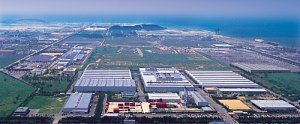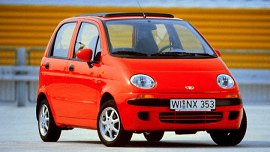
| General Motors (USA) |
| - |
Main plants: Bupyung (Gentra, Tosca, Windstorm), Gunsan (Lacetti), Changwon (Matiz).

2010: 1,842,374 units* (domestic sale: 125,730 units)
2007: 1,886,632 units*
2006: 1,520,000 units*
2005: 1,150,000 units
2004: 900,000 units
2003: 580,000 units
* A large number of cars produced were badged as Chevrolet, Pontiac, Holden and Buick for export.
Previously, Suzuki also sold rebadged Leganza in the US market in order to fill its vacancy in mid-size cars. As a result, it acquired minority stakes in GM Daewoo.
Note: since Jan 2011, GM Daewoo becomes GM Korea and the Daewoo brand gives way to Chevrolet. Following its full integration into GM, it would be meaningless to continue updating this page. From now on related information will be reported on the GM page instead.
However, GM still controlled the development of its cars. Daewoo did not really involve much its new car development because GM could always find some outdated designs from its backyard - for example, Opel Kadett became Daewoo Le Mans / Racer. This car was also rebadged as Pontiac for sale in North America as GM wanted to make use of its cost advantage to fight against Japanese cars. The project gave Daewoo the first taste of large volume export as well as a modern assembly plant with annual capacity of 170,000 units.
GM quit in 1992 as it sold the remaining stakes to Daewoo group. As the US influence withdrew, Daewoo started developing its own cars. That called for hunting ex-Porsche engineer Ulrich Bez to head its engineering operation, setting up R&D centers in Europe and subcontracting development jobs to overseas consultants. Besides, Italian design houses were employed to style its new cars. The result was a trio of new models, Lanos, Nubira and Leganza, all launched in 1997. Next year arrived its smallest car, Matiz, designed by Giugiaro based on a proposal abandoned by FIAT Punto. Daewoo also established a joint-venture in Poland with FSO to produce Matiz for European market.
 Matiz (1998)
Matiz (1998)The Asian financial crisis in 1997/98 hit South Korea hard. Many companies went burst because of their high debt level resulted from over-expansion in the last few years. Daewoo received the SUV maker Ssangyong in 1998, but this ownership lasted for less than two years, because Daewoo itself also went into bankruptcy in 2000.
It wasn't too bad indeed. Operated under creditor banks, Daewoo kept production as usual and even introduced some decent new models - Kalos, new generation Lanos, Nubira and Lacetti.
In 2002, GM came back and bought the majority assets of Daewoo. The company was renamed to GM Daewoo. GM also invested to upgrade its R&D and quality control, improving its product lineup. As Daewoo had poor quality image overseas, its cars were rebadged as Chevrolet for the American and European market and sold as Holden in Australia. In the latter half of 2000s, GM built its Korean subsidiary into a leading development center for its global small car platform (Delta), not merely a production base. The first fruit was the 2008 Lacetti, which was derived into Chevrolet Cruze.
In early 2011, the name Daewoo finally came to the end. GM Daewoo was renamed to GM Korea, while its domestic cars were rebranded to Chevrolet.